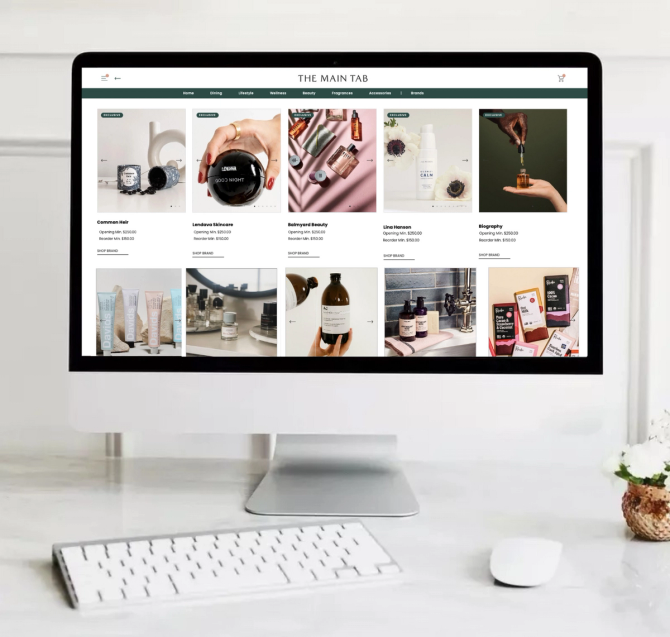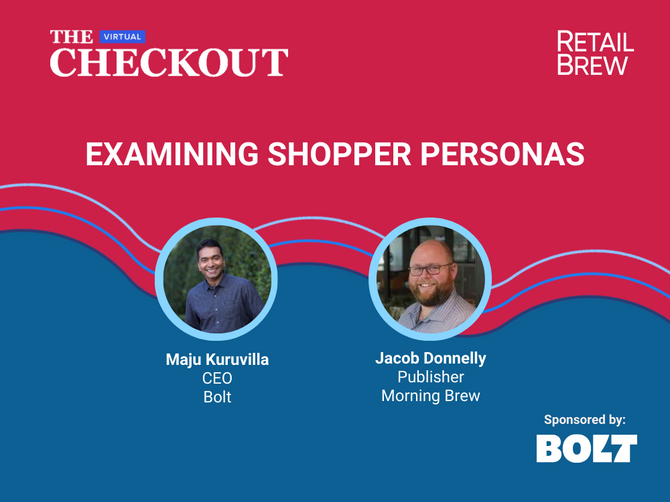Let’s start the week on a cautionary note. Context is everything, friends, which is why a McDonald’s next to a crematorium in Cornwall, England, agreed to remove a sign recently. The sign was promoting a sandwich called the “McCrispy.”
In today’s edition:
—Jeena Sharma, Maeve Allsup, Andrew Adam Newman
|
|
The Main Tab
Liseda Shelegu, founder of The Main Tab—a curated luxury wholesale marketplace—said she went into the wholesale biz “accidentally.” After graduating from college in 2010, Shelegu, originally from Albania, started working in sales at Nest Fragrances, where her job was to identify “high-end boutique stores across the country, pitch the collection to them via phone, and sell the brand,” she told Retail Brew.
The business continued to grow as Shelegu was able to place the candles across several boutique stores. On the side, another idea started brewing in her head: What if she could create one single marketplace for luxury beauty, lifestyle, and home brands that could eliminate the middleman, aka the agency, and connect the brands directly with sales reps from these stores?
“I noticed that all of these other brands out there that were really nice…didn’t know how to approach this boutique market. It was very challenging,” she explained. “You either had to hire a really expensive, robust team, or had to outsource it to independent or sales agency reps, or you did it in-house and were more reactive versus proactive.”
Plus, the whole process required money, so Shelegu set out to build what she calls a “high-end Alibaba.” “The stores are smart. They know their customer. They know what they want. Why aren’t we giving them an e-commerce experience for wholesale?” she said.
Enter: The Main Tab, which was founded in early 2020. After taking an initial hit during the pandemic, the platform closed $1 million in pre-seed funding in 2022 and notched 133% in growth since then.
The online marketplace currently houses about 180 brands and, per Shelegu, offers a unique proposition by “disrupting” the agency model and “bringing independent sales reps on board.”
Keep reading here.—JS
|
|
|
Whether you’ve slipped on a pair or not, you know Steve Madden. They’ve been creating fashion-forward shoes and styles since the ’90s, and this iconic brand wanted to take their strategy a step (or two) further.
Looking for ways to keep their iconic styles in their shoppers’ closets, the Steve Madden team went beyond designing shoes that shoppers love: They embraced Bluecore’s predictive intelligence.
Bluecore took a deep dive into Steve Madden’s story and how predictive intelligence changed their business, helping them offer shoppers fresh new fits based on their retail data. By leveraging predictive intelligence, the Steve Madden team was able to:
- boost conversion by 37% with category affinity campaigns
- reduce campaign production time by 87.5% using predictive campaigns
- elevate their repeat buyer rate by 22%
Check out the full story here.
|
|
Illustration: Dianna “Mick” McDougall, Photo: Starbucks
In part one of our deep dive into Starbucks Odyssey, we explored the experience itself and what are beta users saying about it. In this second installment, we’re zooming out, and examining the broader impact Odyssey could have on the retail world and its relationship with loyalty programs.
In the months since Starbucks first announced its Web3 loyalty program, Odyssey, the project has been hailed as evidence that major brands are recognizing the mainstream value and potential for mass adoption of Web3 technology.
Both the retail industry and Web3 enthusiasts are watching to see whether Starbucks is building a blueprint that other retailers will follow. And the answer to that question depends on what additional value a Web3 element brings to both brands and consumers that Web2 loyalty offerings can’t.
Lee Barnes, chief data officer at customer experience platform Paytronix, told Retail Brew that while exploring new ways to recognize high-value consumers is always valuable, the key consideration will be whether Odyssey creates a return that is ultimately worth the time and effort for Starbucks.
“It’s the operative question…Is Starbucks leading [the industry] here?” explained Phil Ranta, COO of digital talent management agency We Are Verified. “[Or] are they falling flat on their face?”
Breaking the mold
Ranta said he thinks Starbucks is fulfilling its role as an industry leader.
“The Trojan horse that they’re doing with this is they’re getting a lot of people to connect and authenticate their blockchain wallets, so you’re getting the Web3 addresses of coffee enthusiasts,” Ranta said. “And in the future, that could be super valuable.”
From a Web3 perspective, Starbucks has created the “killer app,” (an app that ensures the success of the technology it’s associated with) by onboarding new users to Web3 while obfuscating the technology, said Jeff MacDonald, social strategy director at ad agency Mekanism. “It’s larger for Web3 as a whole than it may be for Starbucks,” MacDonald told Retail Brew.
Keep reading here.—MA
|
|
|
Send emails that drive revenue. Wanna start crushing your email marketing and boosting conversion rates? Spellbound can help. Their no-code platform helps you create interactive experiences embedded inside of your Klaviyo campaigns so you can send your audience emails that streamline the checkout process in just a few clicks. Go make magic.
|
|
Modern priorities and lifestyles have reimagined the world of commerce, forcing retailers to revisit who and where their customers are—and how to hold on to them. Join us Feb. 23 at 12pm EST for a free virtual event sponsored by Bolt, where we’ll discuss insights from the latest report on shopper personas, the importance of the checkout experience, and more. Register now.
*This editorial content is supported by Bolt.
|
|
Today’s top retail reads.
Factory settings: How Apple’s iPhone production is increasingly shifting from China to India. (CNN)
Not-new England: Fashion resale is reshaping the clothing industry in the UK. “Wearing secondhand is a demonstrable statement of your intention, and a rejection of one of the most polluting industries on the planet,” said Alex Goat, the chief executive of youth culture consultancy Livity. (The Guardian)
Drink pink: “Rosa,” or rosé, tequila is having a moment, with new brands and surging sales. (Forbes)
|
|
-
PayPal CEO Dan Schulman will retire after holding the job for nine years.
-
Bindle issued a consumer safety alert over “a potential lead issue” with its water bottles, following Consumer Reports testing.
-
The NBA will open its first basketball-themed restaurant in Toronto.
-
Subway will stop using pre-sliced meat and will have slicers in stores instead.
-
Mars Wrigley was fined by OSHA for a workplace incident in which two workers fell into a chocolate vat in 2022.
-
Nettie’s House of Spaghetti in Tinton Falls, New Jersey, announced it will ban children under 10 for reasons including “cleaning up crazy messes, and the liability of kids running around the restaurant.”
|
|
At the mall, it’s where band tees are the only tees. In Retail Brew, it’s where we invite readers to weigh in on a trending retail topic.
Last week, Retail Brew’s Jeena Sharma wrote about Playboy, which released a lingerie collection for Valentine’s Day. Jason Mahler, VP of design at Playboy, told us that the line was targeting Gen Z consumers, for whom “there’s a big focus on nostalgia right now.”
We’re going to slip into something a little more comfortable, but before we do…
You tell us: Will the Playboy brand strike a chord with Gen Z lingerie buyers? Cast your vote here.
Circling back: Last week, we asked you about tipflation, about which Retail Brew’s Andrew Adam Newman (that’s me) wrote two stories. Wiktionary defines tipflation as “the phenomenon of tipping becoming both increasingly widespread and expensive (in terms of acceptable percentage) in society.”
Contactless point-of-sale payment systems on touchscreens have gained popularity, and the choose-a-tip prompt increasingly migrated from full-service restaurants to other types of retail. So we asked if you thought it was a good thing that tip-prompt screens are being used not just in full-service restaurants but in more and more retail settings.
You don’t think so. At all. An overwhelming 97.9% of you think tip-prompt screens are being used too much and should be reserved for service-intensive situations like paying at a full-service restaurant or taxi or rideshare. Just 1.6% of you thought tip-prompt screens should be used more broadly in retail settings, while 0.5% of you did not know or weren’t sure.—AAN
|
|
Catch up on the Retail Brew stories you may have missed.
|
|
|
Written by
Jeena Sharma, Maeve Allsup, and Andrew Adam Newman
Was this email forwarded to you? Sign up
here.
Take The Brew to work
Get smarter in just 5 minutes
Business education without the BS
Interested in podcasts?
|
ADVERTISE
//
CAREERS
//
SHOP 10% OFF
//
FAQ
Update your email preferences or unsubscribe
here.
View our privacy policy
here.
Copyright ©
2023
Morning Brew. All rights reserved.
22 W 19th St, 4th Floor, New York, NY 10011
|
|








